

 The Accurate Reloading Forums
The Accurate Reloading Forums  THE ACCURATE RELOADING.COM FORUMS
THE ACCURATE RELOADING.COM FORUMS  Other Topics
Other Topics  Recipes for Hunters
Recipes for Hunters  Roast Chicken With Yoghurt Masala
Roast Chicken With Yoghurt MasalaGo  | New  | Find  | Notify  | Tools  | Reply  |  |
| one of us |
Tandoori Murg Roast Chicken With Yoghurt Masala From Time/Life’s Foods of the World - The Cooking of India (1969):
This dish, with only slightly-different variations, is universal throughout India and Pakistan, a region that I refer to as South Asia. I am making an adapted version of this right now, using chicken thighs that I will grill on my Weber Kettle tomorrow. The chapter discussing grilled and barbecued foods in the Indian volume of Time/Life’s Foods of the World series provides a few slight differences when compared to the recipe above. In the chapter, the chickens are skinned and limes are used instead of lemons. These changes sounded sensible to me, and dovetailed with what little I know about the cuisine, so I did the same. On the flip-side of that, I was forced to take a couple of shortcuts, due to availability of ingredients and other factors. These adaptations will be enumerated below. I began by starting 1 teaspoon of saffron steeping in 3 tablespoons of very hot water:  As is always the case with saffron, the characteristics were simply incredible - a deep, rich, golden hue paired with an earthy, slightly-floral fragrance, carrying the promise of exotic Eastern flavours. This description hardly does justice to this most special of ingredients, and in my opinion saffron is worth every penny that it costs. As the saffron steeped, I collected 1/2 cup of freshly-squeezed lime juice: 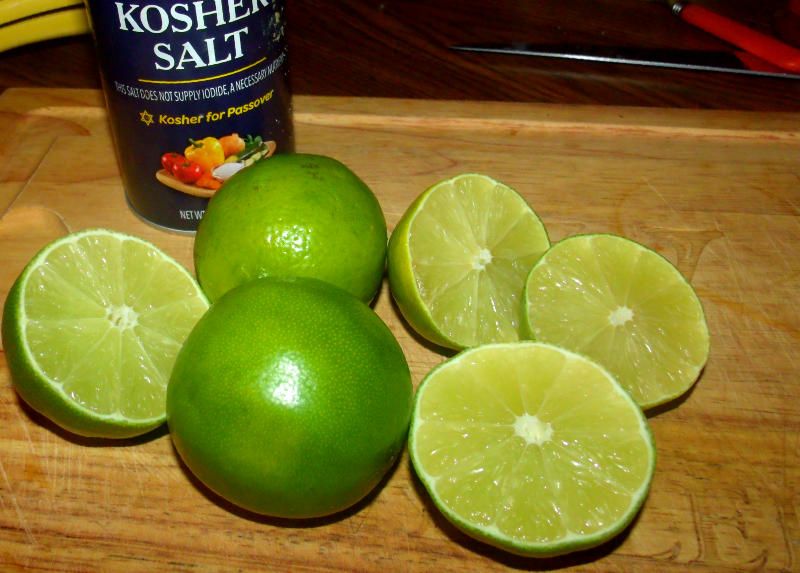 As it turned out, I only needed three limes to get the needed amount, rather than four. The recipe above calls for lemons, and that is perfectly acceptable; however, the chapter preceding the recipe mentioned limes, which are also true to the cuisine, so I used them in order to see how they would work. Once the lime juice was collected, I prepared my boneless, skinless chicken thighs by slashing each of them twice: 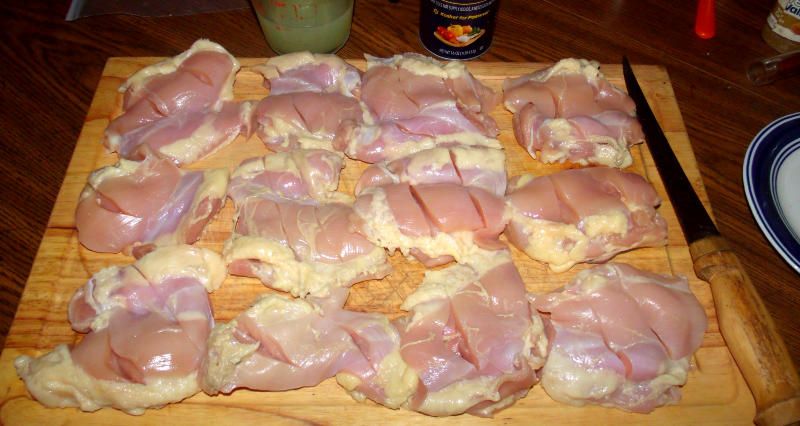 The idea here, of course, is to get the flavour of the spices and other ingredients into the chicken. Next, I combined the lime juice, salt and saffron (along with the steeping water) with the chicken in a large, Zip-Lock-style bag: 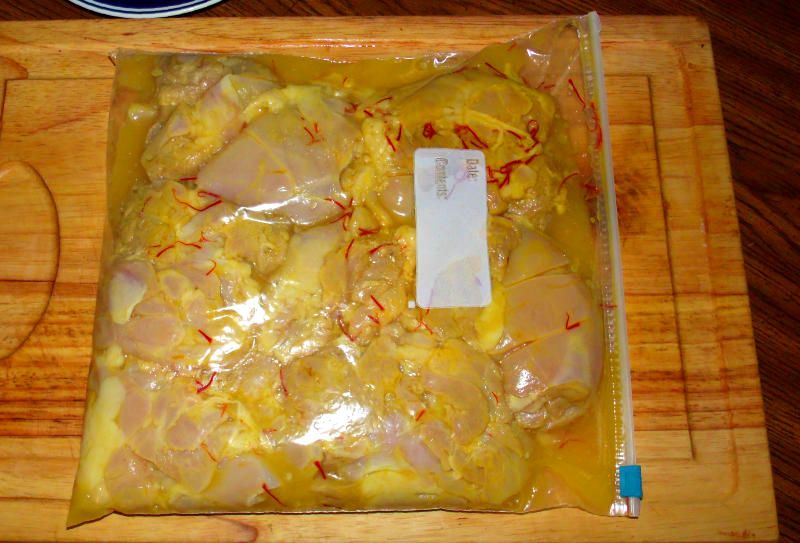 I worked the marinade into the chicken thoroughly, then let the chicken soak it in for 30 minutes, flipping the bag once after 15 minutes. Meanwhile, I assembled my spices and other ingredients: 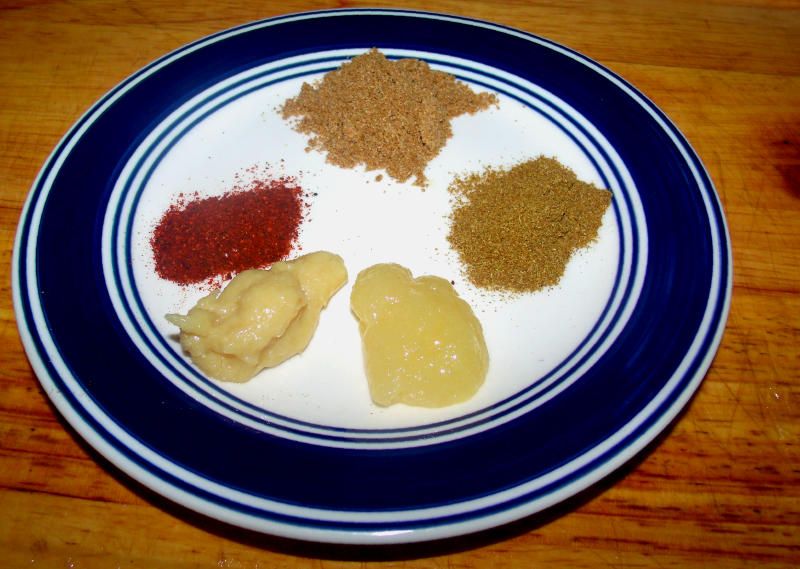 Clockwise from the top: 2 teaspoons of coriander, 1 teaspoon of cumin, about 1.5 tablespoons of ginger paste, 2 teaspoons of garlic paste and about 1.5 teaspoons of commercial chili powder. Because I had no cumin and coriander seeds available to me, I was forced to use good-quality ground versions of those spices; however, I am sure that all will be fine in the end. Also, for the sake of The Beautiful Mrs. Tas, I substituted good-quality chili powder instead of cayenne. I know it is illogical, but she can abide chili powder just fine, whereas even 1/8 of a teaspoon of cayenne (or worse, ground "real" Indian chiles) will have her feeling like she needs to be hospitalized. I have observed this through experimentation over the years and somehow she always knows - and suffers - if I use anything other than chili powder, so I simply use chili powder - happy wife, happy life. Finally, I decided - mostly for the sake of experimentation, to use ginger paste and garlic paste, rather than fresh ginger and garlic. I did this to see how these ingredients would work in a dish such as this, and also because I am skeptical of the “fresh” ginger that is available locally, especially after seeing how “fresh” the “fresh” coconuts and pineapples are. Moving along, I also measured out 1 cup of Greek yoghurt:  The yoghurt, as far as I can tell, aids in the marinating of the meat, and also serves to mellow out the heat that is quintessential to Indian and Pakistani cuisine. When the chicken was finished marinating in the lime juice/salt/saffron mixture, I stirred the spices, ginger and garlic into the yoghurt: 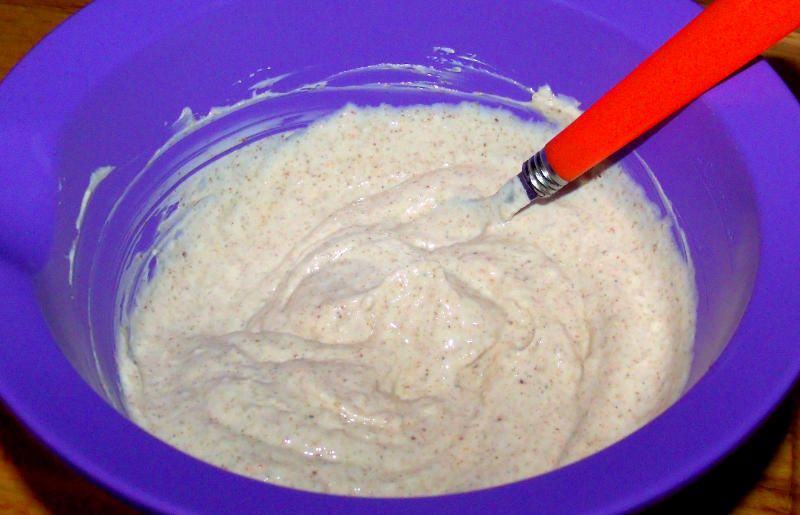 The aromas coming from this combination were incredible, and I suspected that I was in for some wonderful things. I snuck a little taste of the yoghurt masala, and was truly impressed with my first real experience in Indian cuisine. The recipe calls for the use of a 1/2 teaspoon of red food colouring in the masala, to provide a traditional crimson hue. This colouring is mentioned in many, many recipes for this and similar dishes, and appears to be perfectly acceptable; however, some choose not to use if for various reasons. I went back and forth over whether to use this while I was shopping for ingredients, but eventually decided not to; it was just as well, since when I got home I discovered that we didn’t have any red food colouring anyway. Ready to proceed, I added the yoghurt masala to the chicken in the bag, taking care to distribute it evenly and mix it in thoroughly:  And that’s all there is to it, so far. The chicken is currently marinating in the refrigerator until tomorrow, at which time I will grill it over charcoal in my Weber Kettle, perhaps adding a little apple or pecan for a bit of smoky goodness. The kettle - as I will use it - will make a good substitute for the traditional tandoori ovens that are used in India and Pakistan. Part of the actual cooking of the chicken involves the use of ghee, which is a rich, nutty-tasting South-Asian version of clarified butter that is very easy to produce at home and has dozens of uses. I made a batch of ghee earlier today, so I am ready to go with that. It is my intention to serve the finished chicken with a traditional indian salad and perhaps some home-baked naan bread, if I can get it made. More to come as it happens, etc. &c.... | ||
|
| One of Us |
" Because I had no Cumin...." This is hard to believe coming from someone who is great in the kitchen. Let's not hear of this again. | |||
|
| one of us |
I consider myself partially redeemed, Ole Miss! I did have ground cumin, just no cumin seed at the time. Living in rural Montana is awesome, but there are a few challenges that come with it...lol | |||
|
| one of us |
Many Indian dishes are served with salat, often with the main course piled on top of it as part of the presentation. It is extremely easy to make and lends itself well to improvisation; if you don’t like or are missing a particular ingredient at the moment, you can certainly substitute with something else, for the most part. Here is the recipe for the salat that I made to go with the chicken:
Let's give this a go! Here are the ingredients that I used to make my salat: 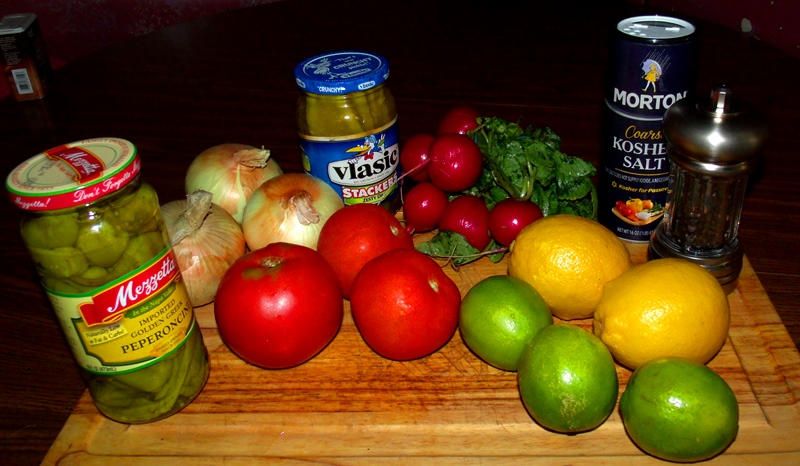 A few notes: The recipe called for two large onions, but my onions weren’t that big, so I used three. Two would have been just about right, I think. I used three tomatoes, rather than two, simply because we had three in the house that needed to be used, and also because I really like tomatoes. I used half the radishes called for, because I’ve never really been a fan of them. As it turns out, they were actually very good in this preparation, but I still think that half was the best amount to use. The commentary in the chapter mentions limes, but the recipe section calls for lemons; I decided to use both of these citrus fruits. My reasons were for the colour contrast in presentation and because I like the way that lemon and lime juice go together. I didn’t have any “fresh hot green chilies,” and The Beautiful Mrs. Tas wouldn’t have let me use them anyway; however, the commentary mentioned that sometimes pickled vegetables are used in salat, and these pepperoncinis seemed like a great idea. Following the pickling concept described above, and remembering that the commentary mentioned cucumbers as a common accompaniment, I also decided to go with slices of “zesty” dill pickles, because they are packed with flavour, including a bit of “hot’ red pepper in the brine. Anyway, if you haven’t guessed by now, this salat is indeed versatile; hopefully, the recipe list and my twists on it will demonstrate the necessary “basics” of it, as well as the possibilities. To get started, I peeled and sliced the onions as thinly as I could with the knife I had, then spread them out evenly on a platter: 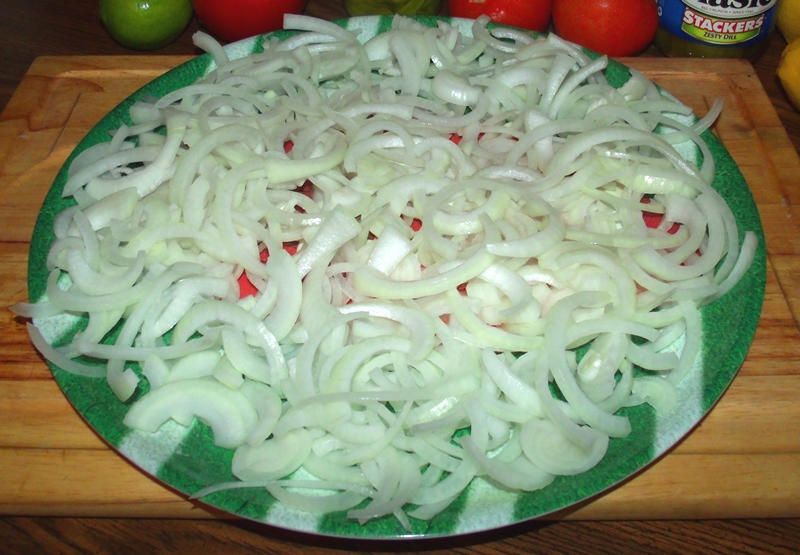 The recipe advises to slice them lengthwise (with the “grain”), but for some illogical reason, I have never been able to stand onions that are sliced that way, so I cut them crosswise (against the “grain”). I doubt that there is a huge difference, either way. I was rather skeptical about the amount of onions - and as it turns out, I probably was slightly over-loaded with them. Having said that, this worked well, so do not be afraid to trust the recipe where the onions are concerned. Once the onions were finished, I sliced the tomatoes and arranged them in a ring near the outer edge of the platter: 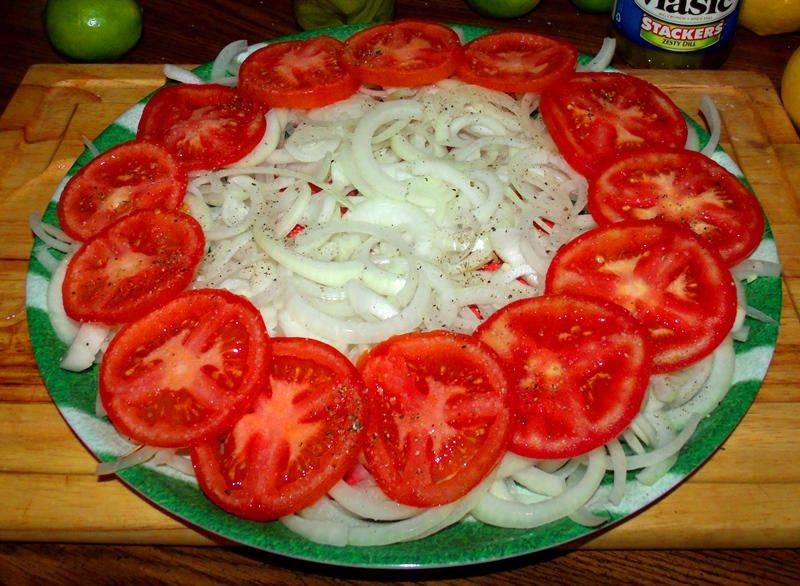 Between each major “layer” of the salat, I sprinkled a bit of salt with a few short grindings of black pepper. I like tomatoes, and in my opinion, I could have put a whole layer of sliced tomatoes over the onions and it would have been great! Next came the radishes: 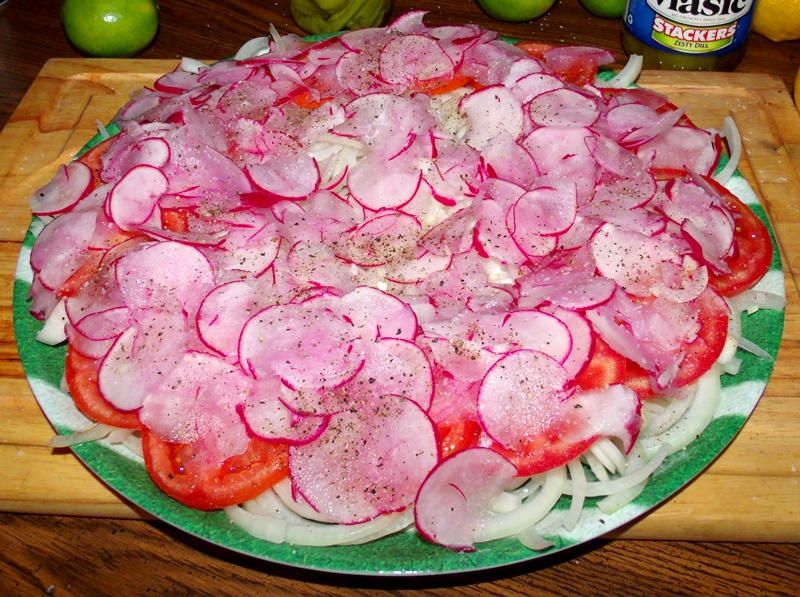 As you can see, I sliced them thinly with a mandolin, both because I really don’t like whole radishes and because I thought they would look nice. Considering the really nice colour combinations I was beginning to get, I am sure that I am not the first person to do this when making an Indian-style salat. The effect was simply too nice, in my opinion, not to have been done before. After the radishes, I cut the lemons and limes into wedges and arranged them around the platter: 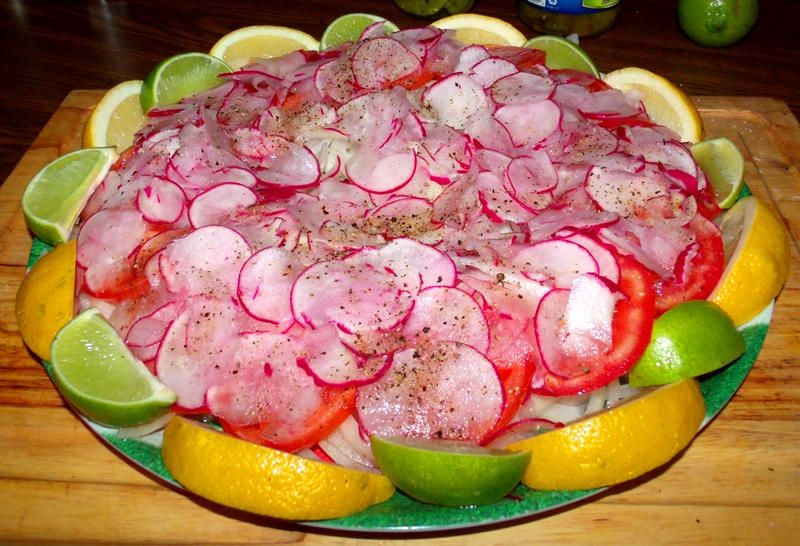 This made a really nice visual impact, and I am glad that I chose to use both fruits; however, one or the other would be just as nice. Next, the slices of pickles:  Slightly-departed from the recipe, but still within the spirit of the cuisine, I hope. After the slices of pickles, I placed the pepperoncinis: 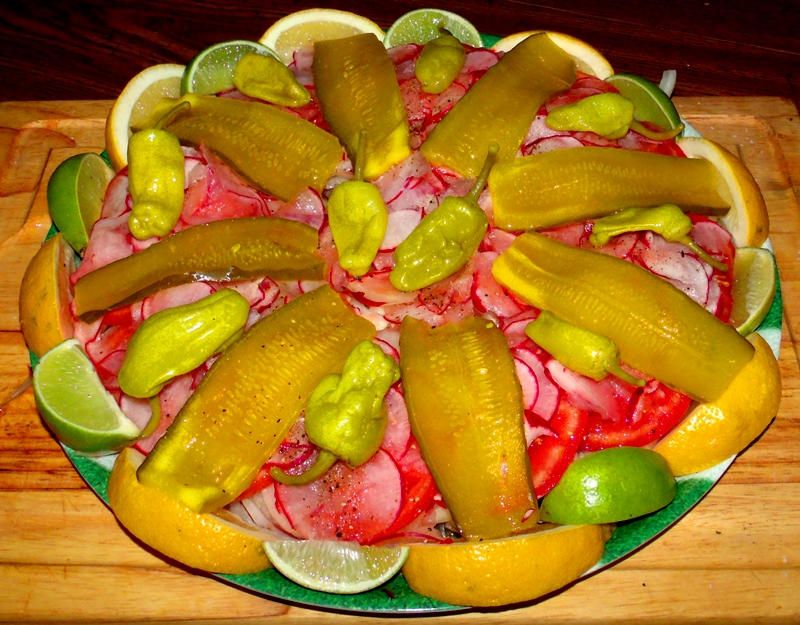 Once again, I am sure that I am not the first to have done something similar. After that, I drizzled the salat with a freshly-squeezed combination of lemon and lime juices. I ended up having close to a half-cup, which is twice what the recipe calls for, but it was all good. And that’s pretty much it! Here is a photo of the finished salat:  As mentioned above, salat is a traditional accompaniment to many Indian meals, especially those cooked over a fire. I was expecting this colourful dish to be pretty good, in spite of my modifications, but was surprised at just how delicious it was. The crisp, raw vegetables all worked very well together, accented by the bright citrus juice, which had the effect of “pickling” the onions and radishes a bit and toning down the harsh bite that I was expecting. I was also pleased with how well it looked from a visual standpoint; the colours are incredible, and really are part of the enjoyment of the dish, in my opinion. Altogether, I was very happy with this side dish and expect to use it many more times, especially when cooking South-Asian cuisine. | |||
|
| One of Us |
Looks as good as it can get! Shame we live so far apart or I would come over and dine with you. | |||
|
| One of Us |
No kidding! | |||
|
| one of us |
From Time/Life’s Foods of the World - The Cooking of India (1969):
Reading the above passage, I was impressed with the influx of knowledge, technique and (using the author’s word) nostalgia that came through the pages, reaching out to me, nearly 50 years later (and by way of her memories, more than 20 years before that), and inspiring me to try this dish. Her descriptions of these meals - not just the food itself, but the time, place, methods and ingredients - paint a picture of Punjabi life that cannot easily be forgotten. My available ingredients and resources necessitated some very slight variations from the author’s description, but I do not feel that the experience was deprived or diminished in the slightest - this was a flat-out wonderful meal, and one that i intend to enjoy many times in the future. When the time came to actually cook the chicken, I removed the pieces from the masala marinade and laid them out on a tray, brushing each thigh with a splash of ghee:  It was looking great, and it smelling even better! The aromatic mix of spices was an exotic feast in itself; I truly believe that the saffron makes the dish here, in the way that it creates beautiful harmonies with some aromas while bringing other subtle aromas closer to the front. The citrus juices also contribute to a sunny, refreshing ambience that plays an exquisite counter to the earthy spices. The resulting melange is much more than the sum of its parts. By this time, my Weber Kettle was good and hot, so I laid the chicken out on the grate, positioning it around the central Vortex: 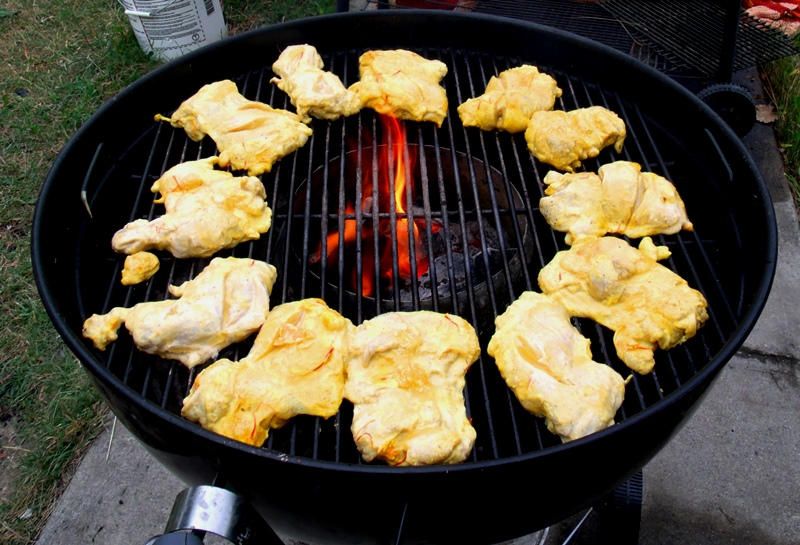 The idea here is that the Vortex concentrates the heat, sending it out to circulate for intense, even heating. It worked very well in my opinion, but please note that your charcoal grill, gas grill or even your oven at high heat will work as well. The Vortex helps you get a little closer to how it's done in India, but there are many ways to skin a cat...or cook a chicken! Because I elected not to use the red food colouring, the chicken took on a wonderful, roasty-golden brown as it cooked: 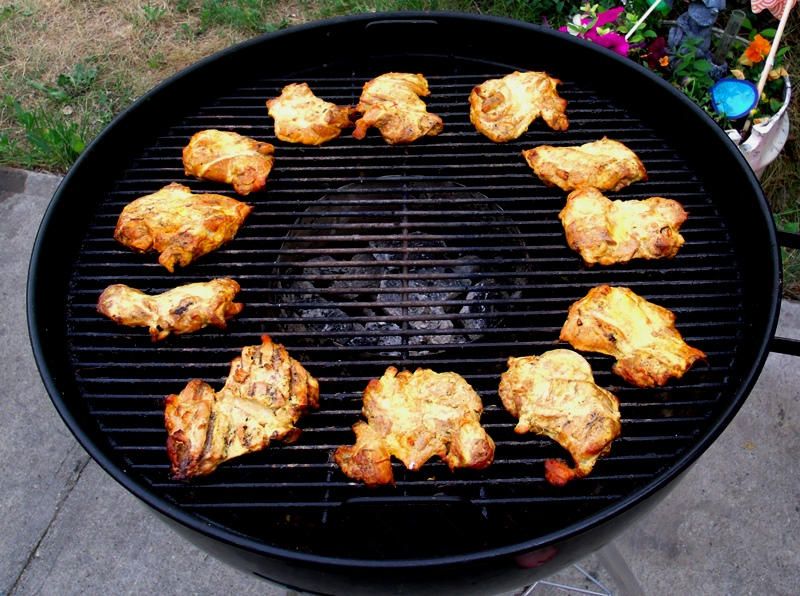 One key point is to baste the surface of the chicken pieces now and then with the leftover masala marinade, for flavor, colour and a nice, slightly-crisp exterior. Not too much, but just enough. I also dashed a little bit of ghee onto the chicken during cooking, as well. By the time they were done, the chicken thighs all looked like wonderful pockets of Punjabi heaven:  What do you think? 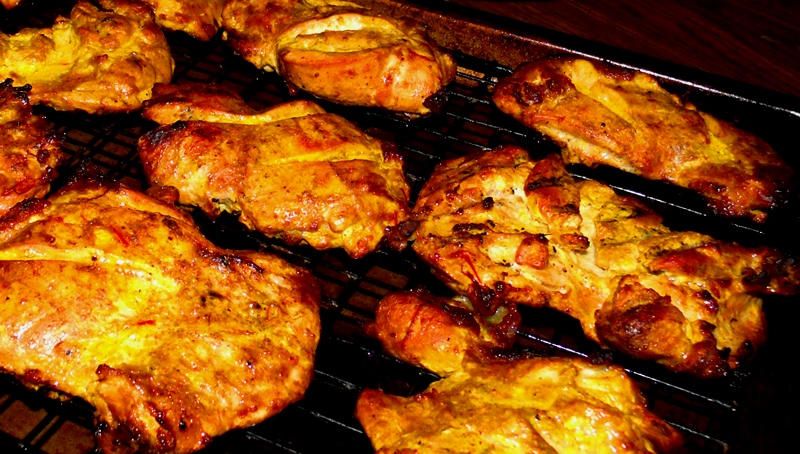 Just looking at these photos, I know that I already want to make this again! In the Punjabi tradition, I served the chicken piled on top of the gorgeous salat: 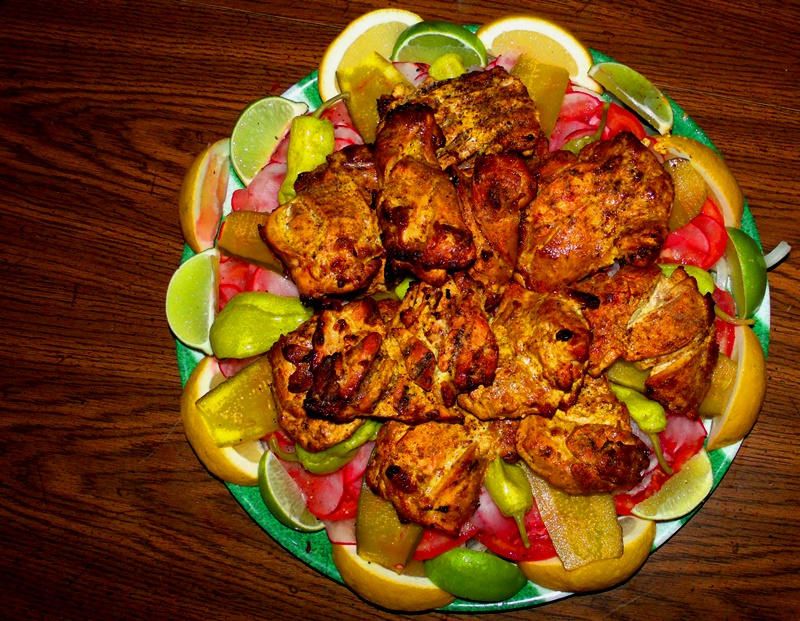 This created what I consider to be a wonderful feast for the eyes as well as the nose, with the promise of absolute paradise for the palate:  When plating the meal, I tried to keep the parade of colours on exhibition, while also keeping things simple; a simple dusting of garam masala and an opportunity for a splash of lemon and lime was really all that was needed: 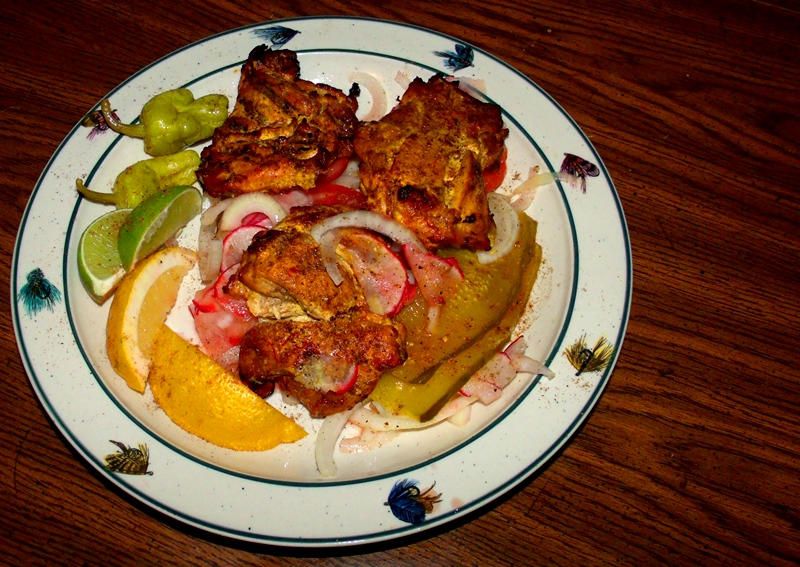 This meal was light and - as far as I can determine - quite healthy; it was also very delicious, with the tender, marinated chicken soaking up the earthy spices and bright citrus and ginger highlights. Just as the commentary above describes, the flavours are found throughout the chicken, and not simple concentrated on the surface. It really was unlike anything I have ever had before; but at the same time, it tasted pretty much the way I expected it to - only better! 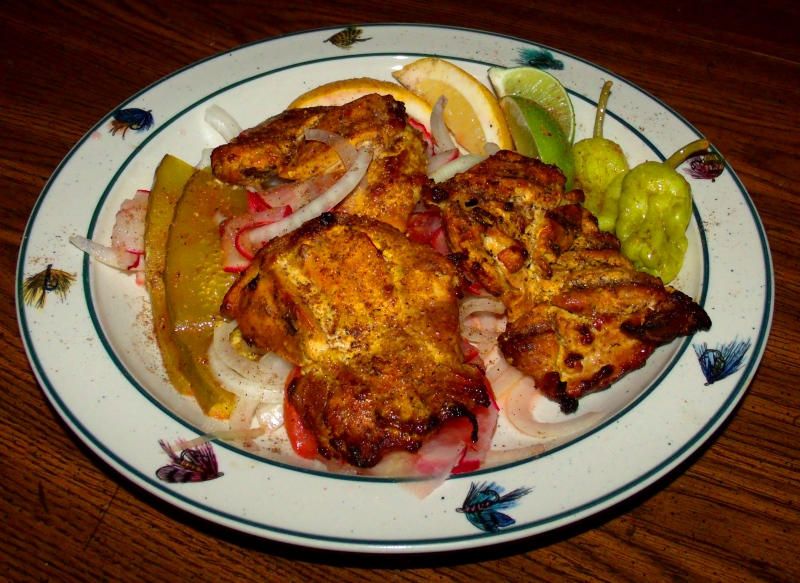 This recipe, like most from the region, is intended to be just a bit spicier, using hotter peppers; the yogurt or curd in the marinade will tone these down a bit, but for those who are sensitive to hot, spicy foods, my chili powder substitutions as outlined above worked very well, bringing the dish into great balance. Everything worked together - the fabulous chicken with its incredible mix of spices, the crisp, raw vegetables and the piquant pickled foods with the citrus dressing - an amazing symphony that belied the simplicity of the ingredients and the preparation. This was truly one of those meals that gives incredible bang for the buck: 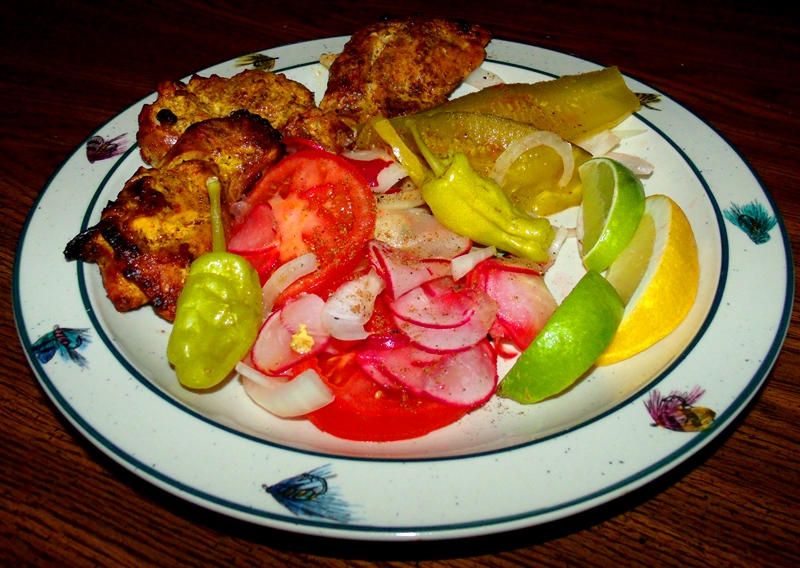 My only regret, and this is 100% my fault, is that this meal screams for a flatbread - any flatbread - and I had none. Even a heated flour tortilla, spread with some ghee, would have been good, allowing the chicken and salat to be wrapped with warm, loving goodness and held in the hand as it was eaten. Due to time constraints, I wasn’t able to make a flatbread for this meal, but I will be sure to do so next time. 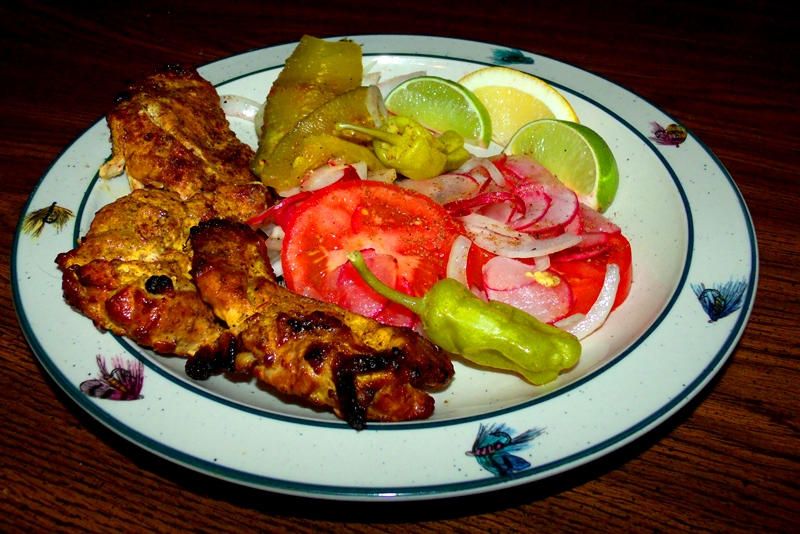 I hope that my demonstration of this traditional Punjabi meal will inspire you to try these incredible recipes; they are not the least bit complicated and can be prepared very easily on your grill at home, or in the oven, if need be. You will not be disappointed, and just might find a new favourite. As always, if there are any questions, please be sure to ask them, and feedback is always welcome. Thank you for taking the time to read this, and if do you do try it, enjoy! Ron | |||
|
| one of us |
Hey, guys - I missed your comments above - thank you! This one was really, really good. I was pretty surprised at how easy it was, and also the depth of favours that I got from it. They are fairly familiar ingredients, just arranged in a different way. Can't be beat! | |||
|
| One of Us |
Have this chicken thigh recipe marinating for tonight's dinner, looking forward to it, thank you very much. Have a suggestion, in place of red food coloring use Sumac instead, I've been playing around with Sumac for a while, it comes in powder form, is red in color and imparts a tart lime flavor. Sadly I'm out of it otherwise I would've put it in the marinade tonight. I also added some Tumeric to the yogurt mixture, not sure what difference it'll make but it's in there. Am also going to grill the flat bread on both sides. | |||
|
| one of us |
Hi, Jim - and I'm glad to see that you're trying this! The sumac sounds like just the ticket - I was thinking of going with some powdered beet or possibly beet juice for the same idea, but I will see if I can get some Sumac. It doesn't grow locally as far as I know, but there are always ways to find almost anything. The turmeric sounds like a really good call - it is a hugely popular spice in India, and stands to reason that it would find its way in there. Variations and experimentation are great! I'm looking forward to the after-action report! | |||
|
| One of Us |
penzeys.com and Amazon among many that offer Sumac for sale. Question, when you drained the marinade off the chicken before grilling did you discard the marinade, I was thinking if there is enough leftover I would bring it to a boil long enough to kill any bacteria and if it's not separated from heating either final coat the grilled chicken or just use it as a dipping sauce? | |||
|
| one of us |
Hi, Jim - I noticed that I failed to address that in my original write-up, so I went back and edited it. What I did was baste the surface of the chicken pieces now and then with the leftover masala marinade, for flavor, colour and a nice, slightly-crisp exterior. Not too much, but just enough. I also dashed a little bit of ghee onto the chicken during cooking, as well. A lot of times I will boil the marinade prior to basting on the grill, but I was concerned about separation as you mentioned, so I simply brushed it on as it was cooking, with the logic that the high temperatures on the cooking would accomplish the same bacteria-killing goals. Considering the high heat required for this grilling and the internal temperature of the finished chicken (it's even hotter on the outside than the inside), I don't believe there are any concerns. Using it as a dipping sauce never occurred to me, but it might taste dang good as one, now that I think about it. I did try the marinade before adding the chicken, and really liked it. If you do give this a try, be sure to boil it, of course - even separated dip is better than raw chicken dip! | |||
|
| One of Us |
This recipe is definitely a keeper, tried reducing the leftover marinade for dipping sauce, didn't really add anything. Thanks again. | |||
|
| one of us |
Hi, Jim - Glad you liked it - thanks for letting me know! I have become a big fan, and intend to prepare this one as much as I can in the future. It's so easy, there's no reason not to! | |||
|
| one of us |
Tas, this one is a visual stunner! Thanks for sharing. I happened to make a "Chicken Tikka Masala with Cashew Cream" dish last night with some overlap of ingredients, but nothing like that salat. It called for pounded chicken breast marinated in yogurt and onion and grilled until starting to char, then diced and mixed with the cashew cream, grilled diced onion, tomatoes, cilantro, garam masala, ginger and other spices. Good stuff! There is hope, even when your brain tells you there isn’t. – John Green, author | |||
|
| one of us |
The only down-side to these discussions is that I always feel like a first-grader listening to professors talk. I also have more fundamental problems. I need them to change the name of "yogurt". Just doesn't sound that appetizing. It certainly does moderate the heat though. | |||
|
| One of Us |
This thread convinced my girlfriend to pick up some saffron over the weekend so we can try this recipe soon! Looks like a delicious alternative to my standard spicy brown mustard and peppery garlic rub treatment for grilled chicken. *It was spectacular- thank you very much Tas for sharing the recipe! "If the women don't find you handsome, they should at least find you handy." | |||
|
| one of us |
Thanks for all of the kind words, guys - I really do enjoy learning about these things and sharing them. Evan - let us know how it turns out! | |||
|
| One of Us |
It was delicious... I did a bunch of de-boned thighs and legs grilled over my Weber like you did with a handful of hickory and cherry wood chips for smoke flavor and the results appeared very similar. Both of us agreed it was a nice change of pace in flavor and definitely a recipe to repeat! Thank you again for sharing. "If the women don't find you handsome, they should at least find you handy." | |||
|
| One of Us |
Dang this is impressive. Very impressive. I will give AR members an alternative short cut Buy Shaan Masala. Its made in pakistan and it is very good. http://www.amazon.com/Shan-Tan...Q-1-75/dp/B000MSNGYM Buy it at local Indian/Ethnic grocery store for $1 a packet. Key is let it marinate for 12-15 hrs. Vary chicken and spice packet content for flavor to suite palate. Again damn impressive. The problem with India food is the spice blend is tough if you do it from scratch. Mike | |||
|
| One of Us |
Great stuff Tas. Do you not get the dark green Indian Chillies there? One other comment - I set the oven on Fan Bake to get an even distribution of heat and the car grilled effect. I do not continue cooking for 1 hour as it dries out the chicken too much. I just fan bake it for 20 minutes on each side & it is crisp on the outside and moist & succulent inside. I change to Fan Grill in the last 5 minutes. Your dish looks restaurant class! "When the wind stops....start rowing. When the wind starts, get the sail up quick." | |||
|
| one of us |
Hello, Naki, and thank you for your feedback. This was a wonderful dish, and I learned a lot by making it. No, unfortunately we do not get and Indian chiles in my area - we are often lucky to get a few jalapenos. For this recipe, I tried using small, pickled pepperoncini from Greece, if I remember correctly. This was partially because that was the closest thing I could think of, but also because The Beautiful Mrs. Tas does not do hot/spicy very well. They worked, for the purpose of what I was trying to achieve, but one day, I will see if I can use something a little closer to "the real thing." Excellent idea for the oven usage, thank you for sharing! I think that the directions in the recipe I posted were for a whole chicken, which might explain the longer cooking time. When I grilled the chicken thighs, it was only for a few minutes on each side, and they were wonderful crispy-tasty on the outside, succulent and moist inside. This was incredible! I am currently looking at a similar dish from Iran that must be related - more on that as I get closer to the project.... Ron | |||
|
| one of us |
Tas, do share your Iranian dish when you can! There is hope, even when your brain tells you there isn’t. – John Green, author | |||
|
| One of Us |
I do my whole tandoori chicken and cornish hens in a Traeger wood pellet grill. They turn out great. Not traditional as a tandoor is a high temp short cooking time contraption. Every time I look at this thread I get hungry. I need to do the Salat next time I make the Tandoori chicken. Mike | |||
|
| One of Us |
This recipe is still a favorite. Tried it with turkey thighs over the weekend. 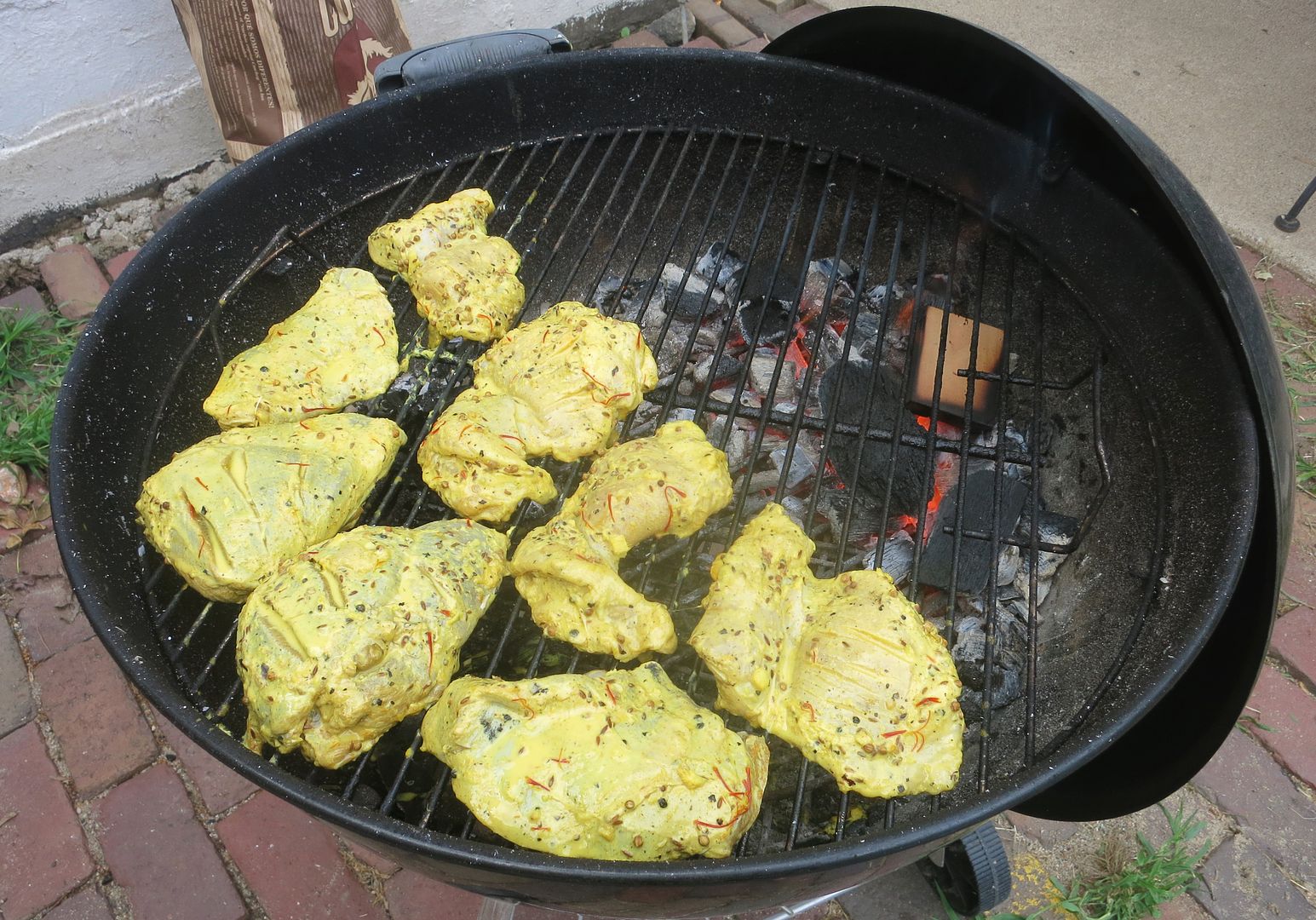 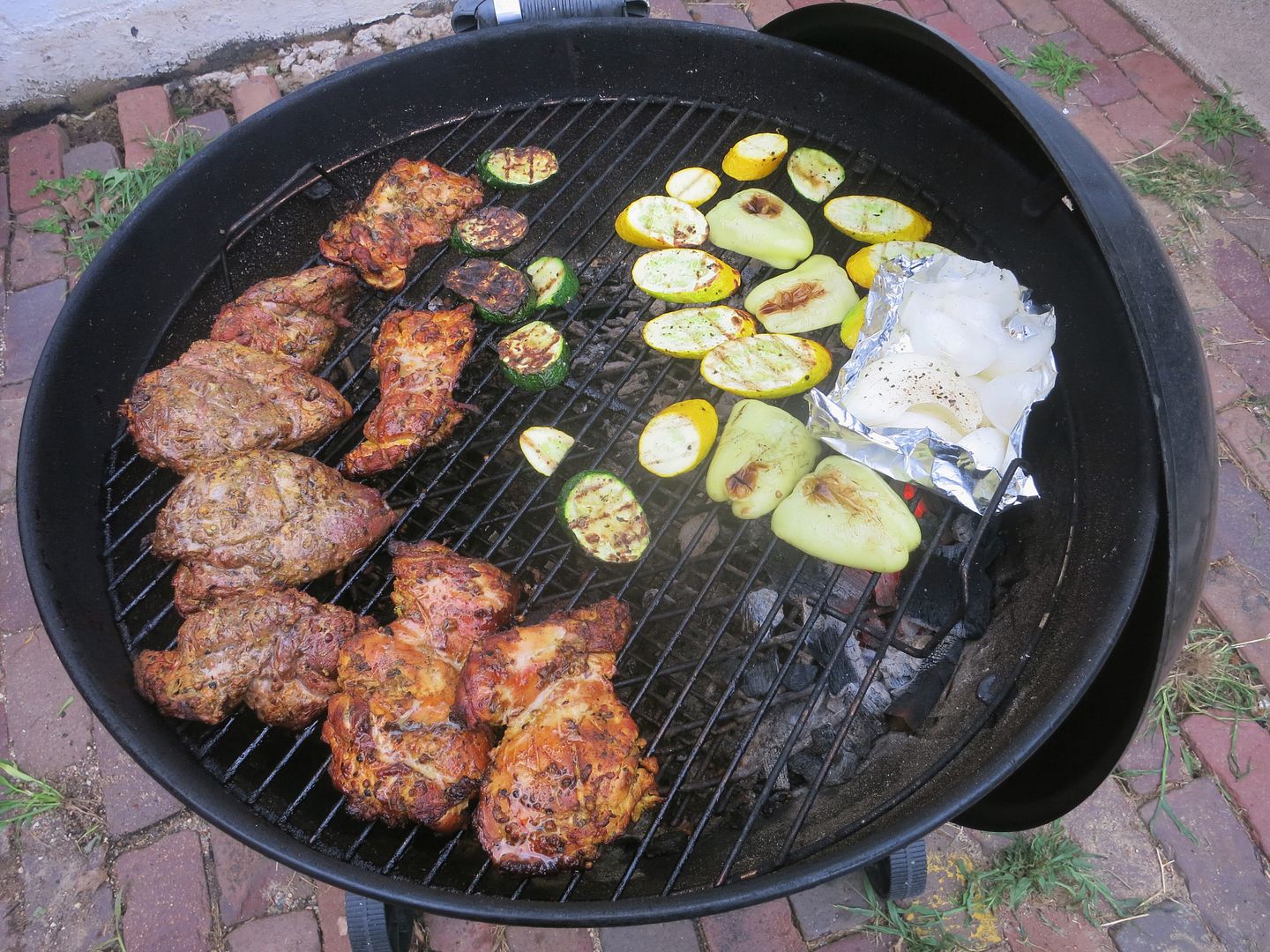 "If the women don't find you handsome, they should at least find you handy." | |||
|
| Powered by Social Strata |
| Please Wait. Your request is being processed... |
|
 The Accurate Reloading Forums
The Accurate Reloading Forums  THE ACCURATE RELOADING.COM FORUMS
THE ACCURATE RELOADING.COM FORUMS  Other Topics
Other Topics  Recipes for Hunters
Recipes for Hunters  Roast Chicken With Yoghurt Masala
Roast Chicken With Yoghurt Masala

Visit our on-line store for AR Memorabilia

